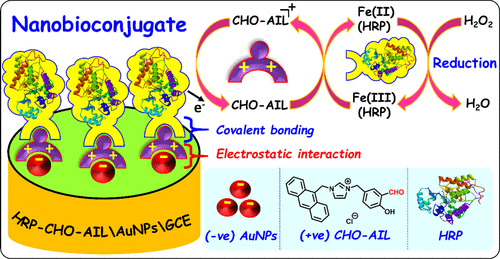当前位置:
X-MOL 学术
›
ACS Biomater. Sci. Eng.
›
论文详情
Our official English website, www.x-mol.net, welcomes your feedback! (Note: you will need to create a separate account there.)
Gold Nanoparticle-Redox Ionic Liquid based Nanoconjugated Matrix as a Novel Multifunctional Biosensing Interface
ACS Biomaterials Science & Engineering ( IF 5.8 ) Pub Date : 2020-10-21 , DOI: 10.1021/acsbiomaterials.0c00807 Kandaswamy Theyagarajan 1 , Sangeeta Yadav 2, 3 , Jitendra Satija 3 , Kathavarayan Thenmozhi 1 , Sellappan Senthilkumar 1
ACS Biomaterials Science & Engineering ( IF 5.8 ) Pub Date : 2020-10-21 , DOI: 10.1021/acsbiomaterials.0c00807 Kandaswamy Theyagarajan 1 , Sangeeta Yadav 2, 3 , Jitendra Satija 3 , Kathavarayan Thenmozhi 1 , Sellappan Senthilkumar 1
Affiliation

|
Creation of interfaces with a prudent design for the immobilization of biomolecules is substantial in the construction of biosensors for real-time monitoring. Herein, an adept biosensing interface was developed using a nanoconjugated matrix and has been employed toward the electrochemical determination of hydrogen peroxide (H2O2). The anionic gold nanoparticle (AuNP) was electrostatically tethered to cationic redox ionic liquid (IL), to which the horseradish peroxidase (HRP) enzyme was covalently immobilized to form a nanobioconjugate. The anthracene-substituted, aldehyde-functionalized redox IL (CHO-AIL) was judiciously designed with the (i) imidazolium cation for electrostatic interaction with AuNPs, (ii) anthracene moiety to mediate the electron transfer, and (iii) free aldehydic group for covalent bonding with a free amine group of the enzyme. Thus, the water-soluble HRP is effectively bonded to the CHO-AIL on a glassy carbon electrode (GCE) via imine bond formation, which resulted in the formation of the HRP-CHO-AIL/GCE. Electrochemical investigations on the HRP-CHO-AIL/GCE reveal highly stable and distinct redox peaks for the anthracene/anthracenium couple at a formal potential (E°′) of −0.47 V. Electrostatic tethering of anionic AuNPs to the HRP-CHO-AIL promotes the electron transfer process in the HRP-CHO-AIL/AuNPs/GCE, as observed by the reduction in the formal potential to −0.42 V along with the enhancement in peak currents. The HRP-CHO-AIL/AuNPs/GCE has been explored toward the electrocatalytic detection of H2O2, and the modified electrode demonstrated a linear response toward H2O2 in the concentration range of 0.02–2.77 mM with a detection limit of 3.7 μM. The developed biosensor ascertained predominant selectivity and sensitivity in addition to remarkable stability and reproducibility, corroborating the suitableness of the platform for the effectual biosensing of H2O2. The eminent performance realized with our biosensor setup is ascribed to the multifunctional efficacy of this newly designed nanobioconjugate.
中文翻译:

金纳米粒子-氧化还原离子液体为基础的纳米共轭基质作为新型多功能生物传感界面。
对于用于固定生物分子的审慎设计,创建接口对于构建用于实时监控的生物传感器至关重要。本文中,使用纳米共轭基质开发了一种灵敏的生物传感界面,并已用于电化学测定过氧化氢(H 2 O 2)。将阴离子金纳米颗粒(AuNP)静电束缚在阳离子氧化还原离子液体(IL)上,辣根过氧化物酶(HRP)酶共价固定在该阳离子氧化还原液体上,形成纳米生物共轭物。明智地设计蒽取代的,醛官能化的氧化还原IL(CHO-AIL),其中(i)咪唑阳离子与AuNPs进行静电相互作用,(ii)蒽部分介导电子转移,以及(iii)游离醛基与酶的游离胺基共价键合。因此,水溶性HRP通过亚胺键的形成有效地结合在玻璃碳电极(GCE)上的CHO-AIL上,这导致HRP-CHO-AIL / GCE的形成。E °')为-0.47V。阴离子AuNPs与HRP-CHO-AIL的静电束缚可促进HRP-CHO-AIL / AuNPs / GCE中的电子转移过程,这可通过形式势降低至-0.42来观察V随峰值电流的增加而增加。HRP-CHO-AIL / AuNPs / GCE已用于电催化检测H 2 O 2,修饰电极在0.02–2.77 mM的浓度范围内对H 2 O 2表现出线性响应,检测极限为3.7微米 除了出色的稳定性和可重复性之外,开发的生物传感器还确定了主要的选择性和灵敏度,从而证实了平台对H 2进行有效生物传感的适用性。O 2。通过我们的生物传感器设置实现的卓越性能归因于这种新设计的纳米生物共轭物的多功能功效。
更新日期:2020-11-09
中文翻译:

金纳米粒子-氧化还原离子液体为基础的纳米共轭基质作为新型多功能生物传感界面。
对于用于固定生物分子的审慎设计,创建接口对于构建用于实时监控的生物传感器至关重要。本文中,使用纳米共轭基质开发了一种灵敏的生物传感界面,并已用于电化学测定过氧化氢(H 2 O 2)。将阴离子金纳米颗粒(AuNP)静电束缚在阳离子氧化还原离子液体(IL)上,辣根过氧化物酶(HRP)酶共价固定在该阳离子氧化还原液体上,形成纳米生物共轭物。明智地设计蒽取代的,醛官能化的氧化还原IL(CHO-AIL),其中(i)咪唑阳离子与AuNPs进行静电相互作用,(ii)蒽部分介导电子转移,以及(iii)游离醛基与酶的游离胺基共价键合。因此,水溶性HRP通过亚胺键的形成有效地结合在玻璃碳电极(GCE)上的CHO-AIL上,这导致HRP-CHO-AIL / GCE的形成。E °')为-0.47V。阴离子AuNPs与HRP-CHO-AIL的静电束缚可促进HRP-CHO-AIL / AuNPs / GCE中的电子转移过程,这可通过形式势降低至-0.42来观察V随峰值电流的增加而增加。HRP-CHO-AIL / AuNPs / GCE已用于电催化检测H 2 O 2,修饰电极在0.02–2.77 mM的浓度范围内对H 2 O 2表现出线性响应,检测极限为3.7微米 除了出色的稳定性和可重复性之外,开发的生物传感器还确定了主要的选择性和灵敏度,从而证实了平台对H 2进行有效生物传感的适用性。O 2。通过我们的生物传感器设置实现的卓越性能归因于这种新设计的纳米生物共轭物的多功能功效。



























 京公网安备 11010802027423号
京公网安备 11010802027423号